Colorful fairs, laughter, special cultural and ceremonial festivities flourish in the country to greet the harvest season. The rural Bangladesh dresses in gold. The glitters of the newly harvested golden rice bring life to fullest and smile on every faces in Agrahayon (a.k.a Ogrohayon).
Agrahayon, which started on November 17 in the Gregorian calendar this year, is the eighth month in the Bengali calendar. The month marks the beginning of traditional harvest festival of Nabanna/Nobanno. In Bengali, Nobanno means “New Crop”. In the agro-based country Bangladesh, the main crop, rice, is harvested in the month of Agrahayon. Truly, a joyful time in the rural Bangladesh as farmers brings their livelihood home.
Another attraction of “new crop” is the beginning of the pitha season. Predominantly, rice flour is one of the main ingredients for Pitha, which can be either sweet or savory. There are not many Bengalis you’ll find who can refrain from the attraction of pithas. Depending on the region, celebration, and mood there are hundreds of kinds of pitha. Pitha can be steamed, deep-fried, pan fried, or roasted as you have sampled some such as dudh puli, shirgoja and moog pakan previously.
Bhapa pitha is considered to be a classic pitha regardless of the region in Bangladesh. These are steamed rice cakes made out of freshly ground rice flour. Depending on the region, they are either served with beef, fish or vegetable curry. Adding a filling of date coconut and date molasses makes the pithas divine. If date molasses is not available in your pantry, substitute brown sugar.
In my never-ending quest of simplifying recipes, I use store-bought rice flour. Omitting the process of soaking and grinding the rice to make the flour at home saves substantial time and labor. The taste, just like home, just as my mom or my grand mother used to make.
Experience, experiment and relish!
- 2 cups Rice flour
- 1½ cups fresh coconut (or desiccated coconut, unsweetened)
- ½ cup water, additional for steaming
- 1 teaspoon salt
- 1 cup date molasses, coarsely broken into small pieces
- ½ cup milk, if using desiccated coconut (optional)
- Items Needed:
- pieces of white muslin or cheese cloth, about the size of a standard paper napkin
- A deep, small, round bowl to shape pitha
- Special bhapa pitha making pot or saucepan and aluminum foil
- Steps to prepare pitha making pan if you do not have bhapa making pan:
- Fill half of a saucepan with water and cover it with double layers of aluminum foil in such a way that vapor cannot go out.
- Using a fork, make few holes in the middle of the covered foil in such a way that vapors cannot go out when you place the bowl you will be using to make bhapa pitha.
- Steps to prepare pitha:
- Shift flour. Add salt. Add ½ cup coconut.
- Sprinkle small amount of water at a time on the flour mixture to dampen the flour. The flour mixture should neither be like a dough nor like a batter but just wet. Set aside for at least 30 minutes.
- If using desiccated coconut, add the milk and dampen the coconut. Set aside.
- Take water in a separate bowl and soak the muslin or cheese cloth pieces. Set aside.
- Shift the damp flour again through a strainer. You will likely have to sieve the wet flour through the strainer with the help of your palm.
- Boil some water in the pitha making pan by covering the pan with a lid. Proceed to pitha making steps as vapor appears through the holes.
- Steps to make and steam pitha:
- Depending on the size of the bowl, spread flour mixture in the small bowl lightly in a way that only half the bowl is covered.
- Place some coconut and molasses at the center of the bowl.
- Cover the molasses and coconut by spreading more damp flour.
- Take one of the muslins from water, squeeze out water and spread the wet cloth on the bowl of flour.
- Gather the corners of the cloth with the bowl inside and carefully flip the bowl with the help of the cloth on the holes of the pitha making pan. The bowl should now be upside down on the holes of the pan.
- Carefully take out the bowl, gather the corners on top of the flour mixture. The piece of cloth will hold the bowl shaped pitha.
- Steam cook for 6-8 minutes.
- Carefully unwrap the pitha from the cloth and place in a plate with the help of a spatula or spoon.
- Add the hot cloth back to water bowl to soak.
- Using the second piece of cloth repeat the steps for next pitha. Soak the cloth in water when done.
- Rinse, squeeze water of the last cloth piece and use for the next pitha after.
You may also skip the filling and serve with a side of vegetable curry, fish curry of beef rezala.
When you take some mixture in your hand and press, the dampen flour mixture should form a ball at first but then break apart if you try to sit it on a plate.
Bhapa pitha is usually made early morning and the flour is dampen the night before. You can dampen the flour mixture at night and make the delicious pitha in the morning.
Take caution when adding molasses and coconut in the bowl. Do not spread the filling towards the rim of the bowl as pitha may break.
Cooking time will vary depending on the size of the bowl and its thickness.
You can freeze leftover pitha in an airtight container or ziplock bag. Sprinkle some water and heat up in microwave or re-steam and the pithas will taste just like fresh ones.
রেসিপি : ভাপা পিঠা (৬-৮ টি পিঠা)
উপকরণ:
২ কাপ চালের আটা
১ ১/২ কাপ কুড়ানো নারিকেল (বা শুকনা নারিকেল পাউডার )
১/২ কাপ পানি, ভাপার জন্য অতিরিক্ত পানি
১ চা চামচ লবণ
১ কাপ খেজুরের গুড়, ছোট টুকরা করা
যদি শুকনা নারিকেল পাউডার ব্যবহার করেন, ১/২ কাপ দুধ, নারিকেল ভিজিয়ে নেয়ার জন্য (ঐচ্ছিক)
অন্যান্য প্রয়োজনীয় দ্রব্য:
২ টুকরা সাদা পাতলা কাপড়ের টুকরা বা চীজ ক্লথ
পিঠা বানানোর জন্য ছোট, গোল বাটি
ভাপা পিঠা তৈরীর বিশেষ পাত্র বা একটি হাড়ি ও অ্যালুমিনিয়াম ফয়েল
ভাপা পিঠা তৈরীর বিশেষ পাত্র না থাকলে, যেকোনো একটি হাড়ি ও অ্যালুমিনিয়াম ফয়েল দিয়ে ভাপা তৈরীর প্রয়োজনীয় পদক্ষেপ :
১. হাড়িতে অর্ধেক পানি দিয়ে অ্যালুমিনিয়াম ফয়েল দুই স্তরে এমনভাবে লাগান যেন বাষ্প বের হতে না পারে।
২. যে বাটিতে পিঠা তৈরি হবে সেই বাটি হাড়ির উপরের অ্যালুমিনিয়াম ফয়েল স্থাপন করুন। একটি কাঁটাচামচ ব্যবহার করে, এমনভাবে ফয়েলের মাঝখানে ফুটা করুন যেন বাটির চারপাশ দিয়ে বাষ্প বের হতে না পারে।
পিঠা প্রস্তত প্রণালী:
১. আটা চেলে নিন। লবণ ও ১/২ কাপ নারিকেল যোগ করুন।
২. আটায় অল্প পরিমাণ পানি এমনভাবে ছিটিয়ে নিন যেন আটা শুধু ভিজে যায় কিন্তু দলা না বাঁধে। অন্তত ৩০ মিনিটের জন্য সরিয়ে রাখুন।
৩.যদি শুষ্ক নারিকেল ব্যবহার করে থাকেন, নারিকেলে দুধ যোগ করে রেখে দিন।
৪. একটি পৃথক বাটিতে পানি নিয়ে কাপড়ের টুকরা পানিতে ভিজিয়ে রাখুন।
৫. একটি চালুনী দিয়ে আটা চেলে নিন।
৬. একটি ঢাকনা দিয়ে হাড়ির পানি ফুটিয়ে নিন।
পিঠা ভাপানো প্রণালী:
১. যে বাটিতে পিঠা বানানো হবে তার অর্ধেকটায় ভেজানো আটা ছড়িয়ে নিন।
২. বাটির মাঝখানে কেন্দ্রে কিছু নারিকেল ও গুড় রাখুন।
৩. গুড় ও নারকেলের উপর আটা দিয়ে বাটি ভর্তি করে নিন।
৪. পানি থেকে একটি কাপড় নিয়ে পানি চেপে নিন। ভেজা কাপড় পিঠার বাটির আটার উপর ছড়িয়ে নিন।
৫. এবার হািড়র ফুটার উপর কাপড় সহ বাটিটি উল্টিয়ে দিন। খুব সাবধানে বাটি তুলে নিয়ে সঙ্গে সঙ্গে চারদিকের কাপড় আটার উপর তুলে দিন।
৬. ৬-৮ মিনিটের জন্য ভাপে রান্না করুন।
৭. সাবধানে একটি চামচের সাহায্যে, একটি প্লেটের মধ্যে কাপড় সহ পিঠা হাড়ির উপর থেকে তুলে নিন। কাপড় সরিয়ে পিঠা বের করে নিন।
৮. গরম কাপড় পানিতে পরিষ্কার করে রাখুন।
৯. দ্বিতীয় কাপড়ের টুকরা ব্যবহার করে পরের পিঠাটি বানানোর জন্য উপরের পদক্ষেপ পুনরাবৃত্তি করুন।
প্রয়োজনিও কিছু টিপস্ এর জনে্য দয়াকরে আটির্কেল অথবা ইংরেজি রেসিপির নোট সেকশনটা একটু দেখে নেবেন।
[/print_this]

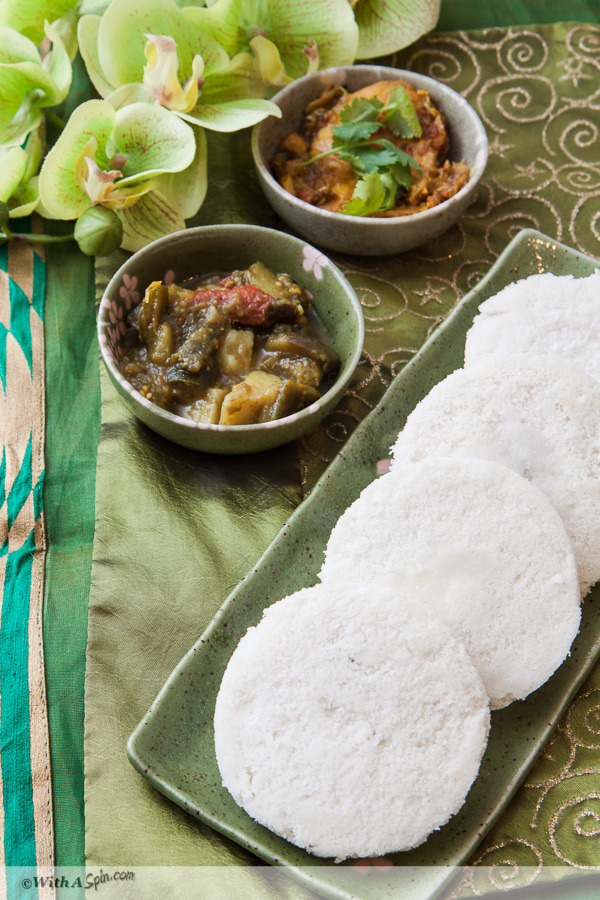
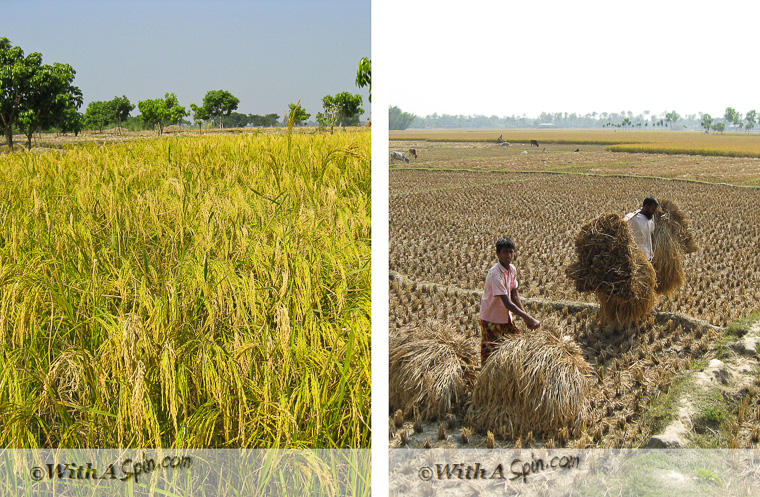
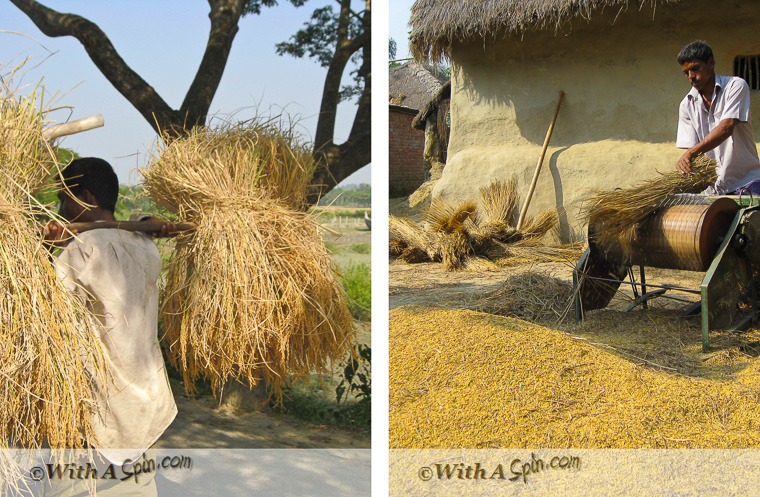
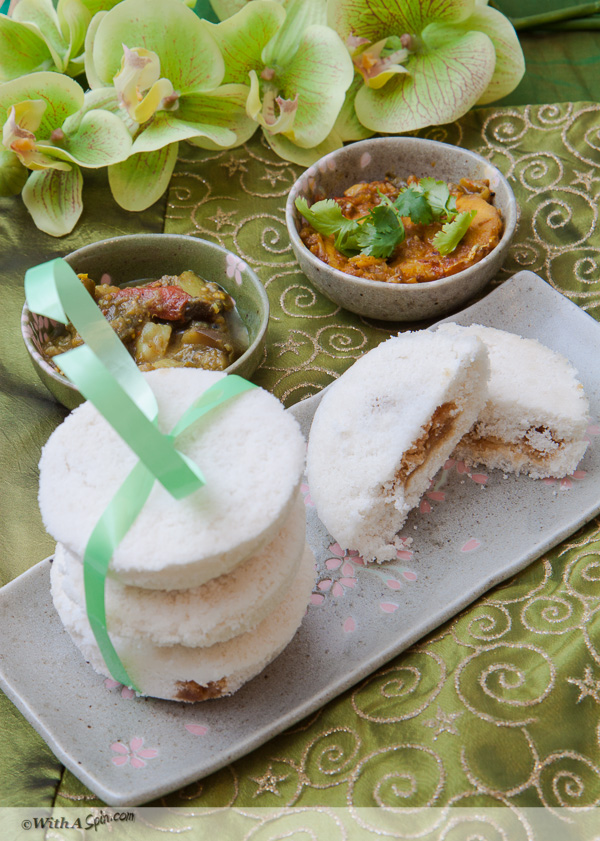
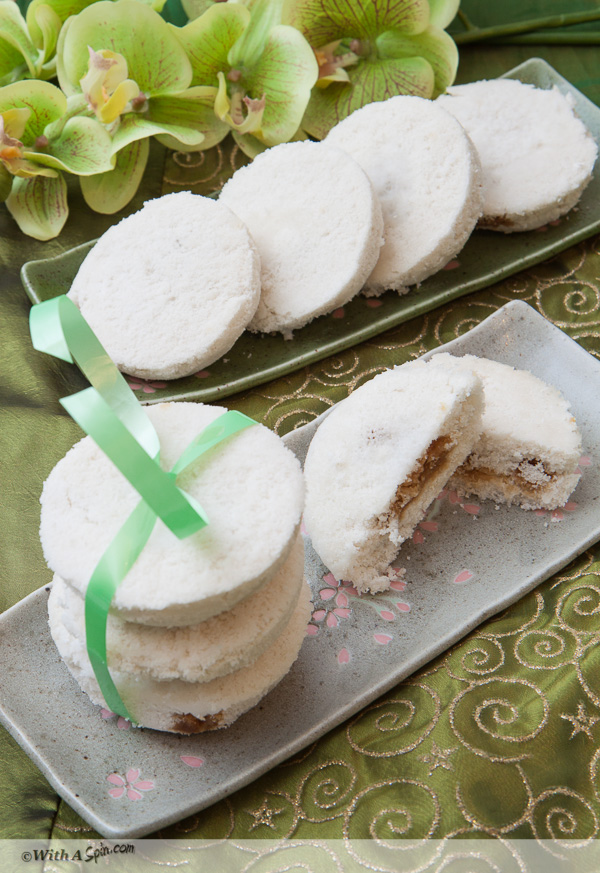

Great post, brings back lot of childhood memories. I remember waking up early in the foggy winter morning in my grandfather’s house way out in the rural Bangladesh almost middle of nowhere. The crowd gathered in the kitchen to prepare fresh rice flour, mixing up and putting in the steaming clay pot. And me and my two sisters waiting in the courtyard for the steamy Bhapa Pitha.
Thank you. Glad the post brought back good memories for you.
Wow. This looks yummy. Thanks for sharing this info about your country.
My pleasure. Thank you so much for coming over.
I always look for recipes with rice flour, I’m comfortable with it yet! But I like to try out new things, This recipe is a original one and definitely something I’d like to eat now. Beautiful pics!
This is a very original pitha of Bangladesh. And a classic one too. I can eat bhapa pitha any day 🙂
Thank you so much, Daniala. If you decide to give it a try, I would love to know how you like them.
What a beautiful post filled with wonderful pictures of your country. The recipe asks for both rice flour and coconut milk, so sign me in…It resembles idli — which I am fan of…
Thank you, my friend. Bhapa pitha does resemble idli but the ingredients are very different. Idli is made of urud dal and bhapa pitha with rice flour. If you pay me a visit, I would love to make some for you. Take care.
Lovely post!
Thank you!
Awesome! Love the texture of the pithas.
Thank you, Sharmila.
What a lovely post and gorgeous pictures! These pithas sound wonderful with the filling and thanks for sharing some of the background information too 🙂
You are welcome, Kelly. The pleasure is all mine. Glad you came over. Thank you!
A post as BEAUTIFUL as it gets!
Those pictures of sublime, sun-kissed, golden paddy fields, faces of rural peasants full of hope, innocence and purity made me all teary; thank you for presenting some gorgeous glimpse of Bangladesh right before my eyes.
And how I wish to indulge myself with some smoking hot, coconut flakes stuffed Vapa pitha!
Inviting, delicious pictures 🙂
Thank you. You are such a wordsmith. Appreciate your presence and the kind words.
A beautiful post and what a nice recipe.
We have something similar to this in the south too, called Puttu, and I just love it.
Thank you, Ash. Is puttu similar to idli? I love idli. The bhapa pitha is a great recipe indeed. Thank you so much for coming over, Ash.
These look delightful
Celebrating harvest is such a wonderful custom. It’s great that you appreciate the bounty.
Totally agree. We can’t take everything for granted and convey thanks where gratitude is needed. Thank you for your wonderful words.
wow–that’s amazing 🙂 Love the photos. The dishes served along side look especially tasty. And I love that you’re on that “never-ending quest of simplify recipes.” Nicely put!
Oh, Liz, I would never be able to cook some of the traditional dishes if I didn’t have a simplified version. Not that I wouldn’t like to try out the laborious steps, I just don’t have that kind of time. As a result, I do some trial and errors and the food turn out pretty good. None of my family or friends complain of the taste, so they must closely resemble the original taste(sssshhhhh, I don’t tell them I didn’t follow all the laborious steps 🙂 )
Thank you. Glad you love the photos. Glad you stopped by. Have a fabulous rest of the week.
Never seen this dish before! Sure looks interesting!!!!
These are very traditional and classic rice cakes and seldom seen at restaurants outside Bangladesh. Thank you for stopping by.
I love your photos and your recipe sounds really interesting. I do not think I have anything like it before. Thank you for sharing your recipe. Have a super day.
Thank you, Bobbi.
Delicious pitha! Thanks for sharing the Bangladesh rituals surrounding Harvest festival. Sounds fun 🙂
Delicious indeed. Thanks a lot, Kiran 🙂
I would sooooooo love to try a Bhapa pitha.
I would love to share some with you, Bintu. Thank you!
That is a beautiful festival to celebrate, the ritual sounds fantastic 🙂
I asked my mum about this dish because I don’t know much about Bangladeshi cuisine but she was drooling as much as me!
Cheers
CCU
P.S I seem to have lost around 1000 subscribers on my blog and I don’t know how, so if you were subscribed, could you resubscribe please? it would really help me out!
Thank you, Uru. I am honored that you and your mum liked the pitha. Bhapa pitha is totally drool worthy. Take care.
P.S. NOw I know why your posts were not showing up on my feed. I’ll resubscribe. I already follow you on FB too 🙂
lovely pitha and a lovely time to celebrate it 🙂
Let’s begin the holidays, right? It’s a wonderful time for this wonderful bhapa pitha. Thank you so much for coming over, Kumar.